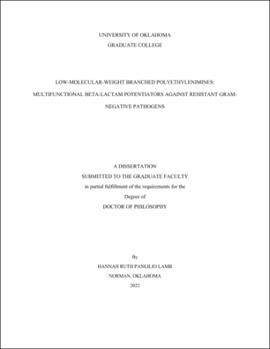| dc.description.abstract | Antibiotic resistance is a simmering threat to the global public health system. Currently, it is estimated by the Centers for Disease Control and Prevention that at least 2.8 million people in the US get infected with antibiotic resistant bacteria annually. Among these resistant pathogens are the multidrug resistant (MDR) Pseudomonas aeruginosa and carbapenem-resistant Enterobacteriaceae (CRE). These resistant pathogens employ various mechanisms such as developing biofilms, transferring genetic elements to convey resistance genes (i.e via extracellular DNA), and employing beta-lactamase enzymes to degrade or evade existing antibiotics. To combat these pathogens, much focus is directed toward identifying new antibiotic classes and modifying known antibiotic scaffolds through high throughput screenings and synthesis. However, these efforts are still moving very slowly. Hence, there is a crucial need for new strategies in battling these life-threatening infections. One way to address this issue is by implementing a co-treatment approach where an anti-resistant potentiator compound is co-administered with existing drugs. Findings from our lab suggest that low-molecular weight branched polyethylenimine (600 Da BPEI) and its poly(ethylene glycol) (PEG)ylated derivative (PEG-BPEI) can potentiate existing beta-lactams and disrupt biofilms. These multi-function potentiators have the ability to chelate essential metal ions involved in the beta-lactamase functions, bind eDNA, improve the uptake of antibiotics, and dissolve mature biofilms. Furthermore, previous findings suggest that 600 Da BPEI can suppress the production of the proinflammatory cytokine IL-8 in human epithelial keratinocytes. Thus, these potentiators may simultaneously work as anti-inflammation and infection prevention agents. These results expand the possible utility of 600 Da BPEI and its derivative, PEG-BPEI, as clinically useful broad-spectrum wound healing agents. | en_US |
